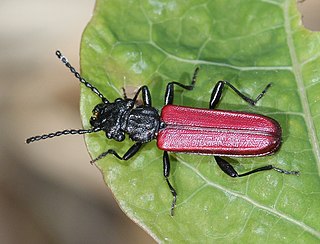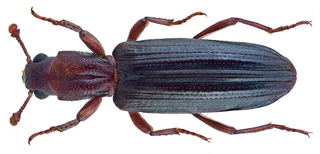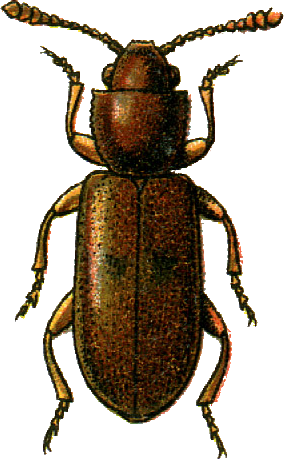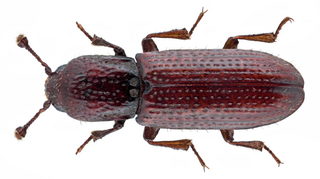
The Cucujidae, or flat bark beetles, are a family of distinctively flat beetles found worldwide under the bark of dead trees. The family has received considerable taxonomic attention in recent years and now consists of 70 species distributed in five genera. It was indicated Cucujus species are scavengers, only feeding on pupae and larvae of other insects and on other subcortical beetles such as their own. Since the Cucujidae prey on larvae of potentially tree damaging beetles that spread fungal diseases, they are considered to be beneficial to the health of living trees.

Zopheridae is a family of beetles belonging to Tenebrionoidea. It has grown considerably in recent years as the members of two other families have been included within its circumscription; these former families are the Monommatidae and the Colydiidae, which are now both included in the Zopheridae as subfamilies or even as tribe of subfamily Zopherinae. Some authors accept up to six subfamilies here, while others merge all except the Colydiinae into the Zopherinae.

Erotylidae, or the pleasing fungus beetles, is a family of beetles belonging to Cucujoidea containing over 100 genera. In the present circumscription, it contains 6 tribes and 10 subfamilies. In other words, the narrowly circumscribed Erotylidae correspond to the subfamily Erotylinae in the definition sensu lato. There are doubts on the monophyly of lower ranked taxa within Erotylidae, with further phylogenetic studies requiring better sampling and studies of unexplored character sets, for example the metendosternite and penile flagellum, which are generally lacking detailed morphological studies within the Coleoptera literature. The Eroytlina taxonomy is based on traits such as their different colors and not off morphological differences like mouthparts, thorax, and abdominal terminalia (Pecci-Maddalena).

Cucujus is a genus of beetles in the family Cucujidae, the flat bark beetles. It contains 19 currently recognized species and subspecies.

Jacobsoniidae are a family of tiny beetles belonging to Staphylinoidea. The larvae and adults live under bark, in plant litter, fungi, bat guano and rotten wood. There are around 28 described species in three genera:

Bothrideridae is a family of beetles in the superfamily Coccinelloidea. They are known commonly as the cocoon-forming beetles or dry bark beetles. They occur worldwide with most native to the Old World tropics. In older literature, the family was often included in the family Colydiidae, but is now considered unrelated.

Laemophloeidae, lined flat bark beetles, is a beetle family in the superfamily Cucujoidea characterized by predominantly dorso-ventrally compressed bodies, head and pronotal discs bordered by ridges or grooves, and inverted male genitalia. Size range of adults is 1–5 mm (0.04–0.2 in) in length. Currently, it contains 40 genera and about 450 species, and is represented on all continents except Antarctica; species richness is greatest in the tropics.

Monotomidae is a family of beetles in the superfamily Cucujoidea. The family is found worldwide, with approximately 240 species in 33 genera. The ecological habits of the family are diverse, with different members of the group being found under tree bark, in decaying vegetation, on flowers and in ant nests. Their ecology is obscure, while at least some species are mycophagous, feeding on the fruiting bodies of ascomycete fungi, Rhyzophagus are predators on bark beetles and possibly Phoridae larvae, with the larvae of some species also being mycophagous.
Silvanus inarmatus is a species of beetles of the family Silvanidae. It occurs in Sub-Saharan Africa, Madagascar, Seychelles and Cape Verde. It is probably an introduced species in Cape Verde. The species was described by Thomas Vernon Wollaston in 1867.

Silvaninae is a subfamily of silvanid flat bark beetles in the family Silvanidae. There are about 11 genera and at least 30 described species in Silvaninae.

Teredidae is a family of beetles in the superfamily Coccinelloidea, formerly included within the family Bothrideridae. There are around 160 species in 10 genera, found worldwide except South America. Teredids are generally found under bark, in the galleries of wood-boring beetles, or in leaf litter. They are thought to be fungivores. The oldest records of the family are Delteredolaemus from mid-Cretaceous aged Burmese amber from Myanmar and a species of Teredolaemus from Eocene aged Baltic amber.
Oryzaephilus acuminatus, is a species of silvan flat bark beetle native to India and Sri Lanka.
Psammoecus delicatus, is a species of silvan flat bark beetle. It can be found in India, Sri Lanka, Taiwan, Singapore, and Indonesia.
Silvanoprus longicollis, is a species of silvan flat bark beetle found in India, Sri Lanka, Malaysia, Java, China, Japan, Madagascar and East Africa.
Psammoecus simoni, is a species of silvan flat bark beetle found in Taiwan, Japan, Philippines, India, Sri Lanka, Malaysia, Indonesia, Madagascar, France (Réunion), and Seychelles.
Psammoecus trimaculatus, is a species of silvan flat bark beetle native to Afro-Oriental region, but introduced to many parts of the world.
Silvanus difficilis is a species of silvan flat bark beetle widespread in Oriental region. It is introduced to Australia via timber and also to Costa Rica.
Silvanus lewisi, sometimes known as Asian silvanid beetle, is a species of silvan flat bark beetle found throughout the Oriental region and introduced to many parts of the world.
Silvanus recticollis is a species of silvan flat bark beetle found in Afro-Oriental regions.













